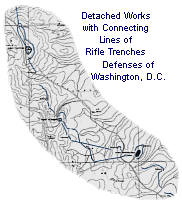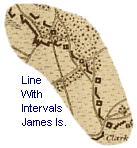 Temporary fortifications designed to cover an extended
position were referred to as entrenched lines. Entrenched lines could either
be composed of a continuous line of nearly uninterrupted parapet or consist
of any number detached works separated by more or less wide intervals. Entrenched
lines might also combine both detached works capable of an independent defense
with continuous stretches of parapet or trench connecting the detached works.
Entrenched lines were also defined by their purpose as Entrenched Positions,
Entrenched Camps, Lines of Circumvallation and Lines of Countervallation.
An entrenched position can be roughly defined as any line of temporary works
constructed for the purpose of protecting a position that either was presently
occupied or might be assumed by an army acting on the defensive. This included
lines constructed to cover important strategic points (such as the defenses
of Washington, D.C.) and hastily constructed works intended to cover the
front of an army in the immediate presence of the enemy. An entrenched camp
was, as the name implies, a line of works constructed for the purpose of
protecting an army's cantonment or camp against an unexpected enemy attack
and assist an army in its winter quarters to maintain its position near the
enemy (such as Fortress Rosecrans). By the middle period of the nineteenth
century lines of circumvallation and countervallation had practically fallen
out of use; a line of countervallation was constructed to enclose a besieged
fortification and prevent the garrison from attempting to break out of the
fortified place. A line of circumvallation was constructed to protect the
rear of a besieging army from enemy field armies attempting to relieve the
besieged garrison. The two together protected a besieging army's camps and
depots of material. Temporary fortifications designed to cover an extended
position were referred to as entrenched lines. Entrenched lines could either
be composed of a continuous line of nearly uninterrupted parapet or consist
of any number detached works separated by more or less wide intervals. Entrenched
lines might also combine both detached works capable of an independent defense
with continuous stretches of parapet or trench connecting the detached works.
Entrenched lines were also defined by their purpose as Entrenched Positions,
Entrenched Camps, Lines of Circumvallation and Lines of Countervallation.
An entrenched position can be roughly defined as any line of temporary works
constructed for the purpose of protecting a position that either was presently
occupied or might be assumed by an army acting on the defensive. This included
lines constructed to cover important strategic points (such as the defenses
of Washington, D.C.) and hastily constructed works intended to cover the
front of an army in the immediate presence of the enemy. An entrenched camp
was, as the name implies, a line of works constructed for the purpose of
protecting an army's cantonment or camp against an unexpected enemy attack
and assist an army in its winter quarters to maintain its position near the
enemy (such as Fortress Rosecrans). By the middle period of the nineteenth
century lines of circumvallation and countervallation had practically fallen
out of use; a line of countervallation was constructed to enclose a besieged
fortification and prevent the garrison from attempting to break out of the
fortified place. A line of circumvallation was constructed to protect the
rear of a besieging army from enemy field armies attempting to relieve the
besieged garrison. The two together protected a besieging army's camps and
depots of material.
 Entrenched
lines were also defined by the general outline of the works composing them
and means provided by that outline of producing crossing columns of fire
for their close defense. The most common types mentioned in period manuals
include continuous lines such as redan lines, tenaille lines, cremaillere
lines, Entrenched
lines were also defined by the general outline of the works composing them
and means provided by that outline of producing crossing columns of fire
for their close defense. The most common types mentioned in period manuals
include continuous lines such as redan lines, tenaille lines, cremaillere
lines,
 bastion lines, and lines with intervals. Redan lines were basically
simple lines of parapet or trench with projecting redans at intervals that
were intended to produce columns of fire that crossed in front of the currents
connecting the redans. Tenaille lines were composed of an alternating series
of regularly spaced salient and bastion lines, and lines with intervals. Redan lines were basically
simple lines of parapet or trench with projecting redans at intervals that
were intended to produce columns of fire that crossed in front of the currents
connecting the redans. Tenaille lines were composed of an alternating series
of regularly spaced salient and
 re-entering angles. Cremaillere lines combined a connected
series of faces broken forward from the general direction of the line that
were joined by short flanks that produced columns of fire across the faces.
Bastion lines were composed of a series of flat bastions (or lunettes) connected
by curtains. Another type of line not dealt with in most manuals was the
irregular indented line that was composed of flattened and re-entering angles. Cremaillere lines combined a connected
series of faces broken forward from the general direction of the line that
were joined by short flanks that produced columns of fire across the faces.
Bastion lines were composed of a series of flat bastions (or lunettes) connected
by curtains. Another type of line not dealt with in most manuals was the
irregular indented line that was composed of flattened and
 irregular
alternating salient and re-entering angles; these were similar in some regards
to tenaille lines with the faces adapted in both length and angular orientation
to take advantage of a fortified position's terrain. These types of continuous
lines could only be applied to positions that could not be turned and were
used when the defending army did not expected to deliver a counter blow to
the enemy army assaulting the lines. Lines with intervals were generally
composed of works capable of an independent defense with their faces oriented
to project crossing columns of fire across the intervals between the works.
Theory generally specified a main or retired line of enclosed works (redoubts)
with an advanced line of works open at the gorge (redans or lunettes). This
type of line was particularly useful for a defending army that was strong
enough to assume a irregular
alternating salient and re-entering angles; these were similar in some regards
to tenaille lines with the faces adapted in both length and angular orientation
to take advantage of a fortified position's terrain. These types of continuous
lines could only be applied to positions that could not be turned and were
used when the defending army did not expected to deliver a counter blow to
the enemy army assaulting the lines. Lines with intervals were generally
composed of works capable of an independent defense with their faces oriented
to project crossing columns of fire across the intervals between the works.
Theory generally specified a main or retired line of enclosed works (redoubts)
with an advanced line of works open at the gorge (redans or lunettes). This
type of line was particularly useful for a defending army that was strong
enough to assume a
 tactical offensive as soon as the army assuming the
offensive had been disordered and thrown into confusion by its attack
on the detached works. tactical offensive as soon as the army assuming the
offensive had been disordered and thrown into confusion by its attack
on the detached works.
A variety of different types of lines were adapted to fortify
positions during the American Civil War. The defenses of Washington, D.C.
(and other important cities)
 combined detached enclosed field works sited on commanding ground
with nearly continuous combined detached enclosed field works sited on commanding ground
with nearly continuous
 lines of rifle trenches that connected the detached forts.
The Williamsburg (Virginia) line across the Yorktown Peninsula and Pemberton's
original line of defense across James Island, South Carolina (Defenses of
Charleston) were both laid out as lines with intervals The first defensive
line (Maury's Line) constructed to protected Mobile, Alabama was a fairly
regular redan line that included several enclosed works and lunettes. Camp
Parapet and the Company Canal defense line that covered the northern approaches
to New Orleans were both typical cremaillere lines; the former's flanks were
anchored on large irregular enclosed lines of rifle trenches that connected the detached forts.
The Williamsburg (Virginia) line across the Yorktown Peninsula and Pemberton's
original line of defense across James Island, South Carolina (Defenses of
Charleston) were both laid out as lines with intervals The first defensive
line (Maury's Line) constructed to protected Mobile, Alabama was a fairly
regular redan line that included several enclosed works and lunettes. Camp
Parapet and the Company Canal defense line that covered the northern approaches
to New Orleans were both typical cremaillere lines; the former's flanks were
anchored on large irregular enclosed
 field works. Fort Pickering at Memphis, Tennessee had its outer
line laid out as an irregular indented line. field works. Fort Pickering at Memphis, Tennessee had its outer
line laid out as an irregular indented line. |